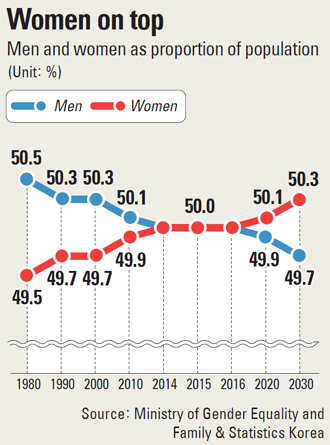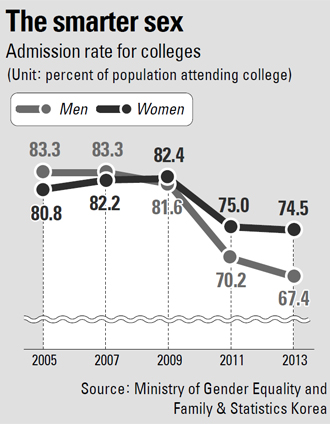Demographically, Korea is now a woman’s world

“It’s hard to see men these days,” says Song, “not just here but everywhere.”
As Korea’s demographics keep evolving, the newest shift is women outnumbering men.
The Ministry of Gender Equality and Family and Statistics Korea estimated in a report released Thursday that Korea’s female population next year will be 25,315,000, surpassing the country’s 25,303,000 males. It is the first time the majority was held by women since statistics were first compiled in 1960.
It is not a temporary phenomenon. If anything, the gap is expected to only widen as time goes by. The report speculated that the number of men per every 100 women is expected to fall to 99.4 in 2020 and 98.6 in 2030. It is currently 100.1.
Men used to outnumber women because of the traditional preference for sons over daughters. In the old days, sons were expected to take care of their elderly parents while daughters, after marriages, became a part of their husbands’ families.
In modern times, daughters have proven to be much better at taking care of aging parents than sons. It shows in the country’s gender ratio at birth, which has changed even in the last 14 years. The number of sons per every 100 daughters was 110.2 in 2000, but it dropped to 105.3 last year, coming into the natural range of 103 to 107.
“I was happy to hear that the baby in my belly was a daughter,” says Lee Hyeon-jeong, a 34-year-old woman due to give birth in October. “Recently, many couples hope for daughters and go as far as to share tips on how to have a daughter rather than a son.”
An imbalance in life expectancies for men and women also plays a big part. According to Statistics Korea, the life expectancy of a Korean woman was 84.6 years as of 2012, compared to a man’s 77.9 years. Out of the 3,485 Koreans who were 100 or older last year, 85 percent, or 2,953 people, were women.

The difference in smoking habits between Korean men and women is striking. The report said that only four out of every 100 women of the age of 20 or older were regular smokers in 2012, compared to 44.9 out of 100 men. On the subject of alcohol, 57.2 percent of women said they were regular drinkers compared to 81.9 percent of men in the same year.
Women started outpacing men in college entrance rates in 2009 and the gender gap has only widened. Last year, 74.5 percent of female students went on to college and universities, when only 67.4 percent of men did.
“In the past, male students outperformed female students in math and science, but they’re now even and girls are sometimes doing better,” says Chung Jae-young, a professor of education at the Ewha Womans University.
The trend is also showing in the examination to go into the civil service. On the foreign service examination, women outpaced men for the first time in 2005, and the ratio of women passing the test increased to 59.5 percent last year. Women accounted for 40.2 percent of those who passed the bar exam last year, up from 18.9 percent in 2000.
Unfortunately, greater numbers don’t automatically translate into greater opportunities.
“It doesn’t mean a lot that women’s ratios have increased in the population because the social status of women still remains low,” says Kim Nan-ju, a researcher of the Korean Women’s Development Institute.
The activity rate - the percentage of people engaging in economic activities - for women last year was 50.2 percent, much lower than men’s 73.2 percent. The employment rate of women last year, at 53.9 percent, was also below the average for Organization for Economic Cooperation and Development (OECD) countries, which was 57.2 percent.
While 42.8 percent of all government officials are female, women only accounted for only 8.8 percent of high government officials last year. “It is more important to make more positions for women and tighten the gap of salaries between men and women,” Kim says.
BY KIM HYE-MI [bongmoon@joongang.co.kr]










with the Korea JoongAng Daily
To write comments, please log in to one of the accounts.
Standards Board Policy (0/250자)